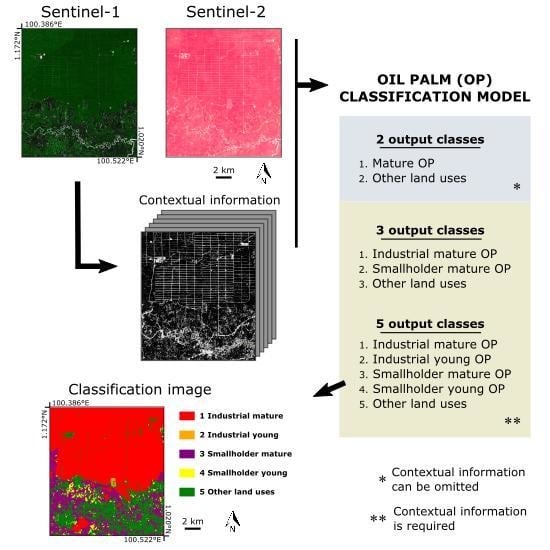Oil Palm (Elaeis guineensis) Mapping with Details: Smallholder versus Industrial Plantations and their Extent in Riau, Sumatra
Abstract
1. Introduction
2. Materials and Methods
2.1. Data and Study Area
2.1.1. Sentinel Missions
2.1.2. Training and Validation Data Collection
2.1.3. Study Area
2.2. Algorithm Overview
2.2.1. Sentinel-1 and Sentinel-2 Compositing
2.2.2. Feature Extraction
2.2.3. Feature Selection
2.2.4. Random Forest Classification
2.3. Accuracy Assessment and Model Selection
2.4. Post-Processing
- Morphology operations (closing) to remove misclassifications of mature smallholder plantations, particularly inside the mature industrial plantations.
- Reclassification of smallholder young plantations misclassified as industrial young plantations. We reclassified the disconnected patches with a size lower than 150 pixels.
- Mode filter to remove salt-and-pepper effects with a squared-kernel of 3 pixels of diameter.
3. Results
4. Discussion
5. Conclusions
Author Contributions
Funding
Acknowledgments
Conflicts of Interest
References
- Susanti, A. Oil Palm Expansion in Indonesia: Serving People, Planet and Profit? Eburon Academic Publishers: Utrecht, The Netherlands, 2016. [Google Scholar]
- Austin, K.G.; Schwantes, A.; Gu, Y.; Kasibhatla, P.S. What causes deforestation in Indonesia? Environ. Res. Lett. 2019, 14, 024007. [Google Scholar] [CrossRef]
- Margono, B.A.; Potapov, P.V.; Turubanova, S.; Stolle, F.; Hansen, M.C. Primary forest cover loss in Indonesia over 2000–2012. Nat. Clim. Chang. 2014, 4, 730. [Google Scholar] [CrossRef]
- Abood, S.A.; Lee, J.S.H.; Burivalova, Z.; Garcia-Ulloa, J.; Koh, L.P. Relative contributions of the logging, fiber, oil palm, and mining industries to forest loss in Indonesia. Conserv. Lett. 2015, 8, 58–67. [Google Scholar] [CrossRef]
- Meijaard, E.; Garcia-Ulloa, J.; Sheil, D.; Wich, S.; Carlson, K.; Juffe-Bignoli, D.; Brooks, T. Oil Palm and Biodiversity: A Situation Analysis by the IUCN Oil Palm Task Force; International Union for Conservation of Nature and Natural Resources (IUCN): Gland, Switzerland, 2018. [Google Scholar]
- Mosnier, A.; Boere, E.; Reumann, A.; Yowargana, P.; Pirker, J.; Havlík, P.; Pacheco, P. Palm Oil and Likely Futures: Assessing the Potential Impacts of Zero Deforestation Commitments and a Moratorium on Large-Scale Oil Palm Plantations in Indonesia; CIFOR: Bogor, Indonesia, 2017; Volume 177. [Google Scholar]
- Austin, K.; Mosnier, A.; Pirker, J.; McCallum, I.; Fritz, S.; Kasibhatla, P. Shifting patterns of oil palm driven deforestation in Indonesia and implications for zero-deforestation commitments. Land Use Policy 2017, 69, 41–48. [Google Scholar] [CrossRef]
- Miettinen, J.; Liew, S.C. Separability of insular Southeast Asian woody plantation species in the 50 m resolution ALOS PALSAR mosaic product. Remote Sens. Lett. 2011, 2, 299–307. [Google Scholar] [CrossRef]
- Lee, J.S.H.; Wich, S.; Widayati, A.; Koh, L.P. Detecting industrial oil palm plantations on Landsat images with Google Earth Engine. Remote Sens. Appl. Soc. Environ. 2016, 4, 219–224. [Google Scholar] [CrossRef]
- Nomura, K.; Mitchard, E.T.; Patenaude, G.; Bastide, J.; Oswald, P.; Nwe, T. Oil palm concessions in southern Myanmar consist mostly of unconverted forest. Sci. Rep. 2019, 9, 1–9. [Google Scholar] [CrossRef]
- Oon, A.; Ngo, K.D.; Azhar, R.; Ashton-Butt, A.; Lechner, A.M.; Azhar, B. Assessment of ALOS-2 PALSAR-2L-band and Sentinel-1 C-band SAR backscatter for discriminating between large-scale oil palm plantations and smallholdings on tropical peatlands. Remote Sens. Appl. Soc. Environ. 2019, 13, 183–190. [Google Scholar] [CrossRef]
- Koh, L.P.; Miettinen, J.; Liew, S.C.; Ghazoul, J. Remotely sensed evidence of tropical peatland conversion to oil palm. PNAS 2011, 108, 5127–5132. [Google Scholar] [CrossRef]
- Szantoi, Z.; Smith, S.E.; Strona, G.; Koh, L.P.; Wich, S.A. Mapping orangutan habitat and agricultural areas using Landsat OLI imagery augmented with unmanned aircraft system aerial photography. Int. J. Remote Sens. 2017, 38, 2231–2245. [Google Scholar] [CrossRef]
- Gorelick, N.; Hancher, M.; Dixon, M.; Ilyushchenko, S.; Thau, D.; Moore, R. Google Earth Engine: Planetary-scale geospatial analysis for everyone. Remote Sens. Environ. 2017, 202, 18–27. [Google Scholar] [CrossRef]
- Meijaard, E.; Sheil, D. The Moral Minefield of Ethical Oil Palm and Sustainable Development. Front. For. Glob. Chang. 2019, 2. [Google Scholar] [CrossRef]
- Chastain, R.; Housman, I.; Goldstein, J.; Finco, M. Empirical cross sensor comparison of Sentinel-2A and 2B MSI, Landsat-8 OLI, and Landsat-7 ETM+ top of atmosphere spectral characteristics over the conterminous United States. Remote Sens. Environ. 2019, 221, 274–285. [Google Scholar] [CrossRef]
- Haralick, R.M.; Shanmugam, K.; Dinstein, I.H. Textural features for image classification. IEEE Trans. Syst. Man Cybern. 1973, 610–621. [Google Scholar] [CrossRef]
- Conners, R.W.; Trivedi, M.M.; Harlow, C.A. Segmentation of a high-resolution urban scene using texture operators. Comput. Vision Graph. Image Process. 1984, 25, 273–310. [Google Scholar] [CrossRef]
- Langley, P.; Sage, S. Induction of selective Bayesian classifiers. In Uncertainty Proceedings 1994; Elsevier: Amsterdam, The Netherlands, 1994; pp. 399–406. [Google Scholar]
- Breiman, L. Some properties of splitting criteria. Mach. Learn. 1996, 24, 41–47. [Google Scholar] [CrossRef]
- Louppe, G.; Wehenkel, L.; Sutera, A.; Geurts, P. Understanding variable importances in forests of randomized trees. In Proceedings of the Advances in Neural Information Processing Systems, Lake Tahoe, NV, USA, 5–10 December 2013; pp. 431–439. [Google Scholar]
- Breiman, L.; Friedman, J.; Olshen, R.; Stone, C. Classification and Regression Trees; Chapman and Hall: Wadsworth, NY, USA, 1984. [Google Scholar]
- Hastie, T.; Tibshirani, R.; Friedman, J.; Franklin, J. The elements of statistical learning: Data mining, inference and prediction. Math. Intell. 2005, 27, 83–85. [Google Scholar]
- Dietterich, T.G. Approximate statistical tests for comparing supervised classification learning algorithms. Neural Comput. 1998, 10, 1895–1923. [Google Scholar] [CrossRef]
- GitHub Repository. Available online: https://github.com/adriadescals/oil_palm_riau (accessed on 25 October 2019).
- Miettinen, J.; Shi, C.; Liew, S.C. Land cover distribution in the peatlands of Peninsular Malaysia, Sumatra and Borneo in 2015 with changes since 1990. Glob. Ecol. Conserv. 2016, 6, 67–78. [Google Scholar] [CrossRef]
- Google Earth Engine Code. Available online: https://code.earthengine.google.com/70a61b2ea4d2e93562397f1acbe6b337 (accessed on 25 October 2019).
- Google Earth Engine Code. Available online: https://code.earthengine.google.com/9be26b9317e8d72eea6f7bcb42f2dc19 (accessed on 25 October 2019).
- Miettinen, J.; Gaveau, D.L.; Liew, S.C. Comparison of visual and automated oil palm mapping in Borneo. Int. J. Remote Sens. 2019, 40, 8174–8185. [Google Scholar] [CrossRef]
- Kussul, N.; Lavreniuk, M.; Skakun, S.; Shelestov, A. Deep learning classification of land cover and crop types using remote sensing data. IEEE Geosci. Remote Sens. Lett. 2017, 14, 778–782. [Google Scholar] [CrossRef]
- Padarian, J.; Minasny, B.; McBratney, A.B. Using deep learning for digital soil mapping. Soil 2019, 5, 79–89. [Google Scholar] [CrossRef]
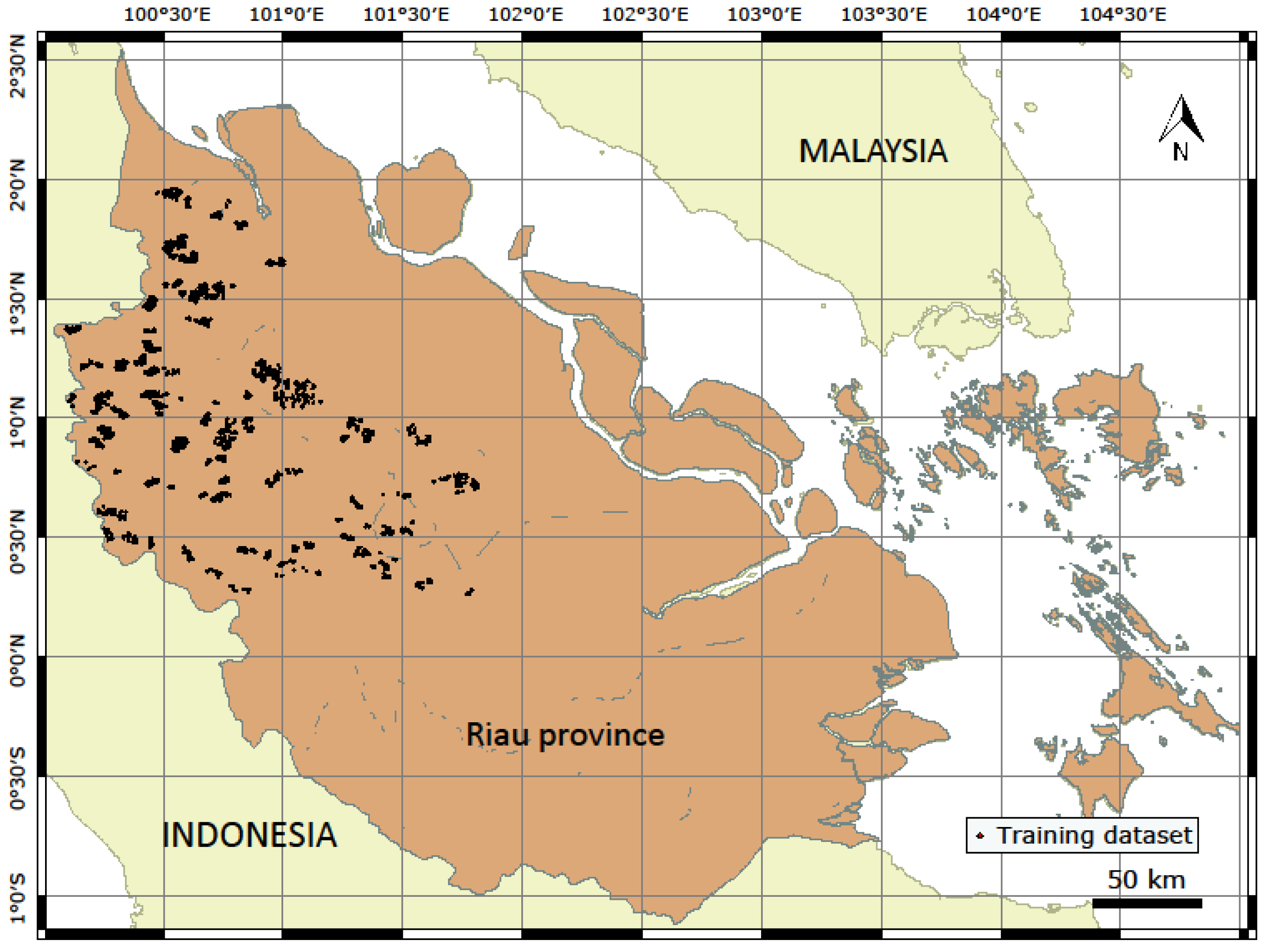
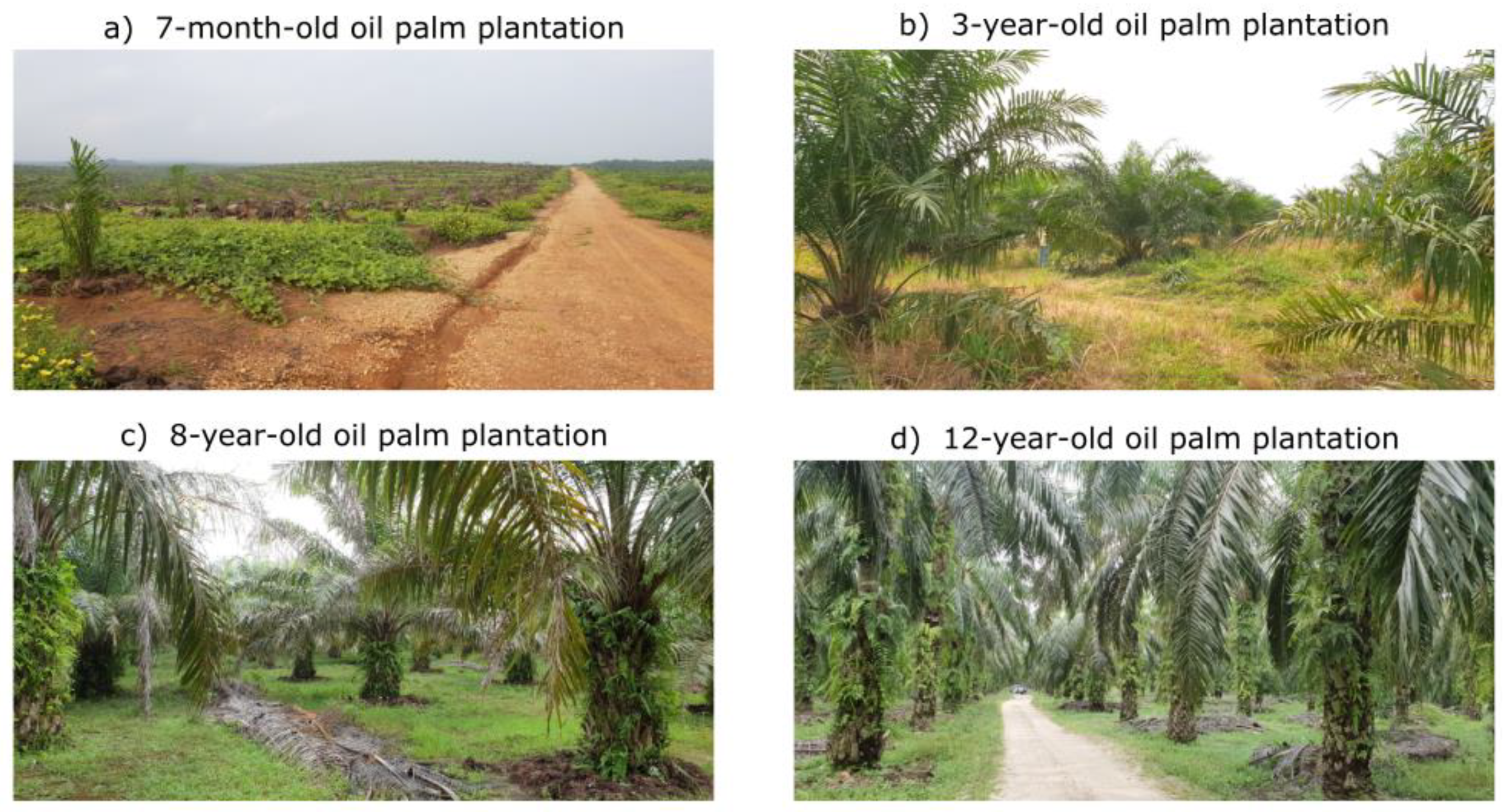
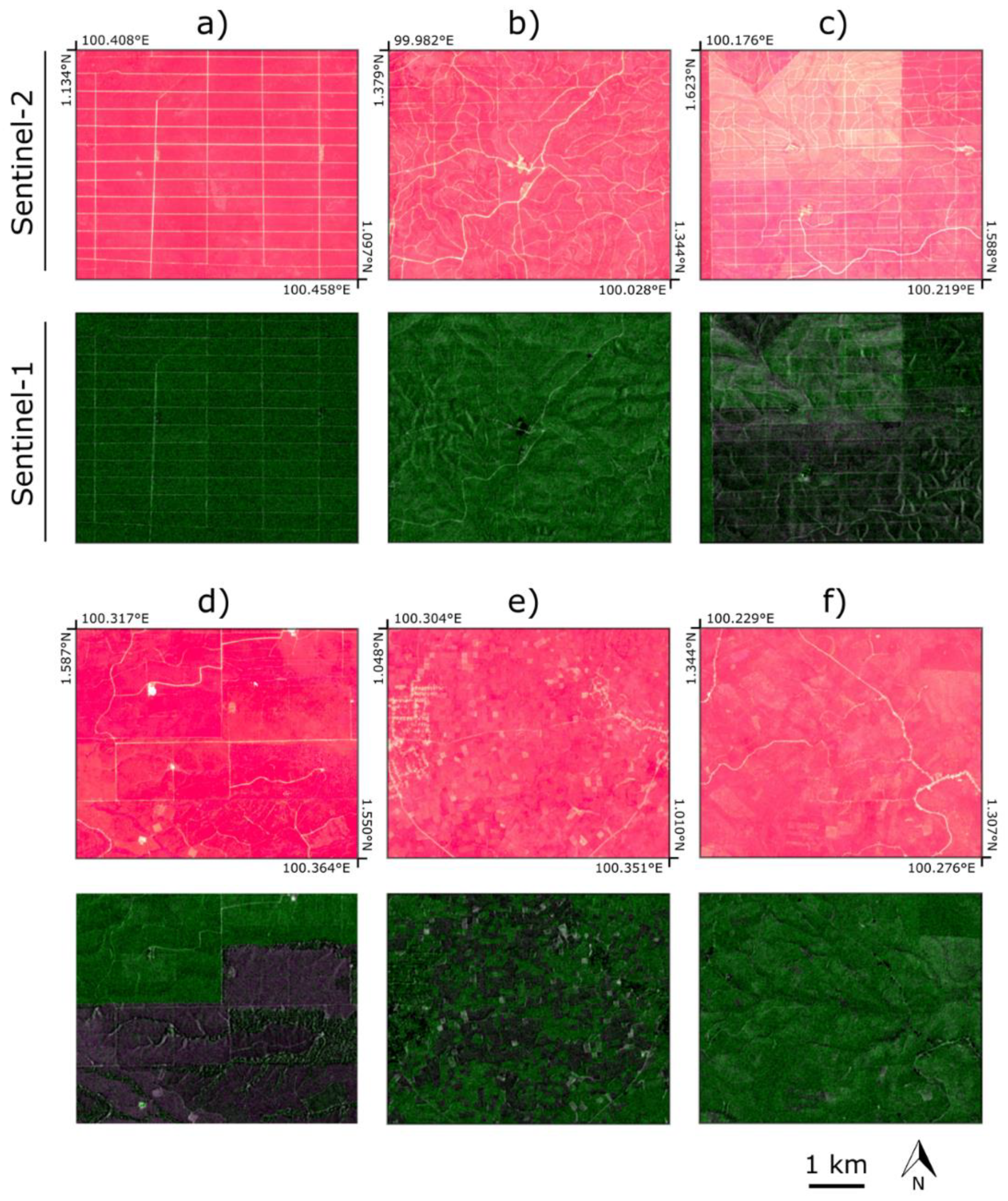


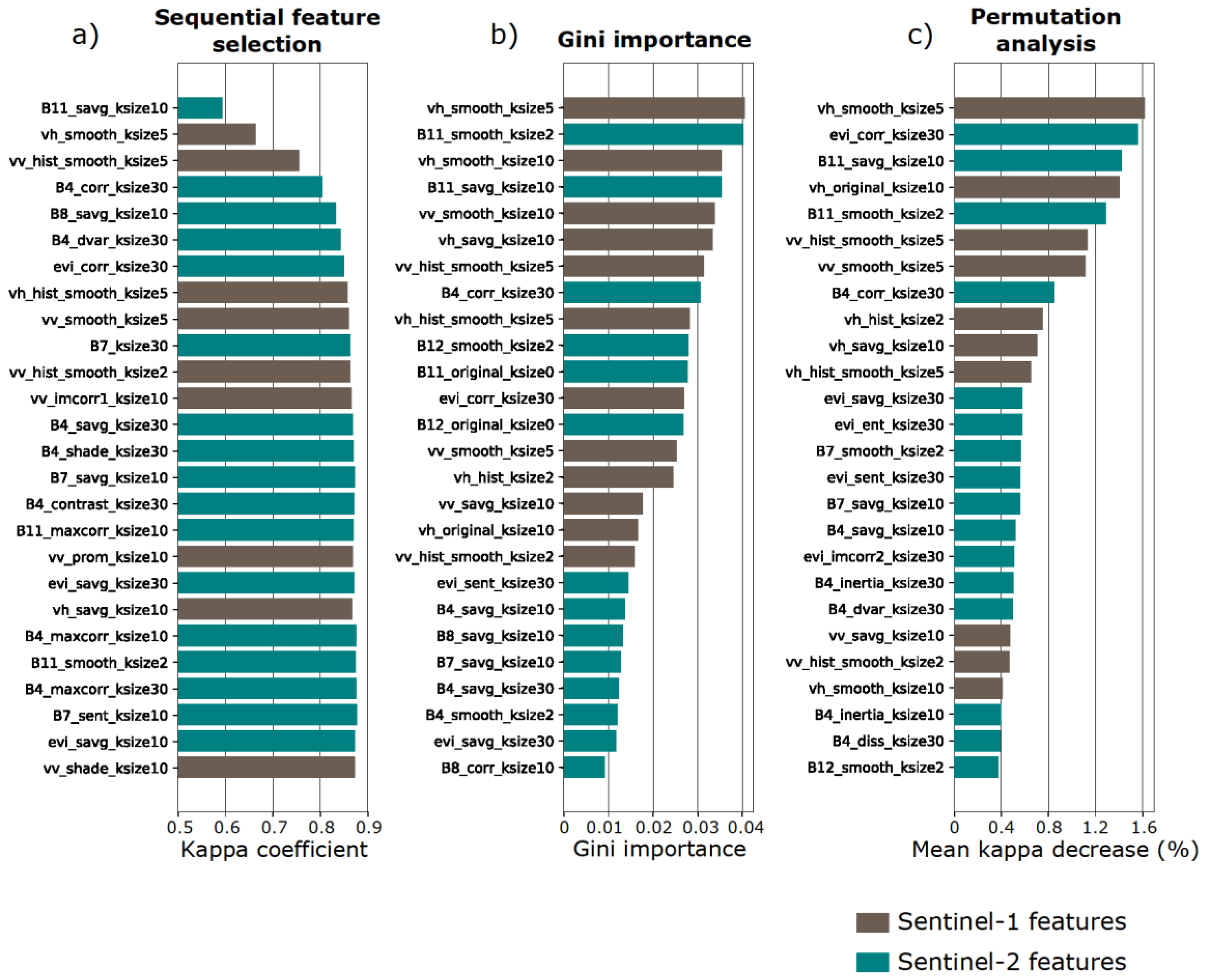


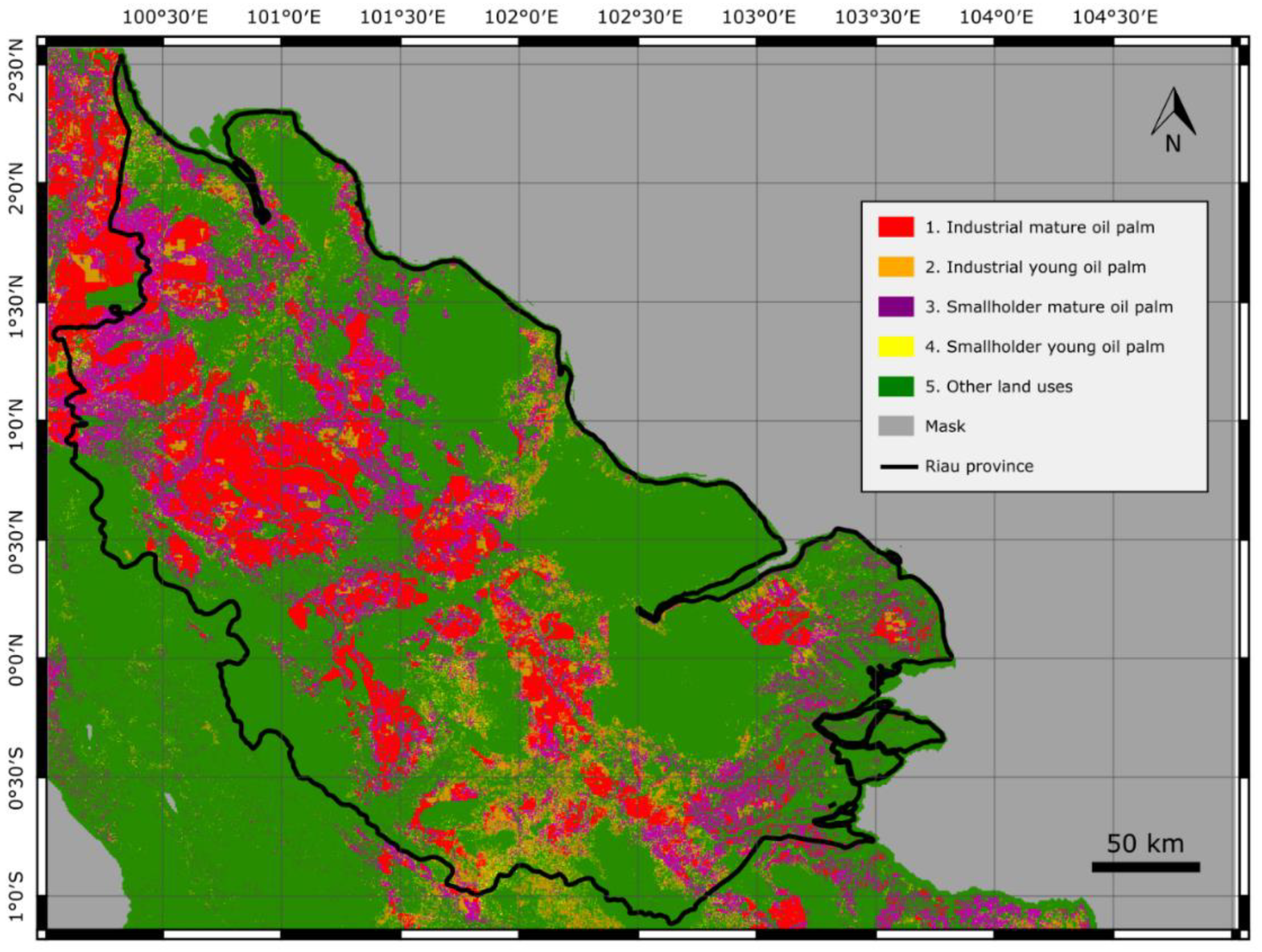
| Operation | Abbreviation | Input Bands | Kernel Size (Pixels) | Ref. |
|---|---|---|---|---|
| Median | smooth | VH, VV, B2, B3, B4, B6, B7, B8, B8A, B11, B12, evi | 2, 5, and 10 | |
| GLCM asymmetry | asm | |||
| GLCM contrast | contrast | |||
| GLCM correlation | corr | |||
| GLCM variance | var | |||
| GLCM inv. dif. moment | idm | |||
| GLCM sum average | savg | |||
| GLCM sum variance | svar | VV_smooth_ksize5, VH_smooth_ksize5 | 10 and 30 | [17] |
| GLCM sum entropy | sent | VV, B4, B7, B8, B11, evi | ||
| GLCM entropy | ent | |||
| GLCM difference variance | dvar | |||
| GLCM difference entropy | dent | |||
| GLCM correlation 1 | imcorr1 | |||
| GLCM correlation 2 | imcorr2 | |||
| GLCM max. correlation coef. | maxcorr | |||
| GLCM dissimilarity | diss | |||
| GLCM inertia | inertia | VV_smooth_ksize5, VH_smooth_ksize5 | 10 and 30 | [18] |
| GLCM cluster shade | shade | VV, B4, B7, B8, B11, evi | ||
| GLCM cluster prominence | prom |
| (a) Sentinel-1 | (b) Sentinel-2 | (c) Sentinel-1 & Sentinel-2 | (d) Sentinel-1 & Sentinel-2 | |||||
|---|---|---|---|---|---|---|---|---|
| (All Bands and Features) | (All Bands and Features) | (Selected Bands and Features) | (All Bands—without Features) | |||||
| Classification Setup | OA (%) | Kappa (%) | OA (%) | Kappa (%) | OA (%) | Kappa (%) | OA (%) | Kappa (%) |
| 5 classes 1 | 78.2 | 71.5 | 79.4 | 73.1 | 90.2 | 87.2 | 78.2 | 71.5 |
| 3 classes 2 | 82.6 | 73.4 | 81.6 | 71.5 | 92.6 | 88.6 | 80.2 | 69.7 |
| 2 classes 3 | 93.5 | 86.9 | 90.3 | 80.5 | 95.3 | 90.5 | 94.3 | 88.6 |
© 2019 by the authors. Licensee MDPI, Basel, Switzerland. This article is an open access article distributed under the terms and conditions of the Creative Commons Attribution (CC BY) license (http://creativecommons.org/licenses/by/4.0/).
Share and Cite
Descals, A.; Szantoi, Z.; Meijaard, E.; Sutikno, H.; Rindanata, G.; Wich, S. Oil Palm (Elaeis guineensis) Mapping with Details: Smallholder versus Industrial Plantations and their Extent in Riau, Sumatra. Remote Sens. 2019, 11, 2590. https://doi.org/10.3390/rs11212590
Descals A, Szantoi Z, Meijaard E, Sutikno H, Rindanata G, Wich S. Oil Palm (Elaeis guineensis) Mapping with Details: Smallholder versus Industrial Plantations and their Extent in Riau, Sumatra. Remote Sensing. 2019; 11(21):2590. https://doi.org/10.3390/rs11212590
Chicago/Turabian StyleDescals, Adrià, Zoltan Szantoi, Erik Meijaard, Harsono Sutikno, Guruh Rindanata, and Serge Wich. 2019. "Oil Palm (Elaeis guineensis) Mapping with Details: Smallholder versus Industrial Plantations and their Extent in Riau, Sumatra" Remote Sensing 11, no. 21: 2590. https://doi.org/10.3390/rs11212590
APA StyleDescals, A., Szantoi, Z., Meijaard, E., Sutikno, H., Rindanata, G., & Wich, S. (2019). Oil Palm (Elaeis guineensis) Mapping with Details: Smallholder versus Industrial Plantations and their Extent in Riau, Sumatra. Remote Sensing, 11(21), 2590. https://doi.org/10.3390/rs11212590






